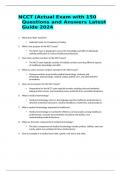NCCT (Actual Exam with 150
Questions and Answers Latest
Guide 2024
1. What does NCCT stand for?
• National Center for Competency Testing.
2. What is the purpose of the NCCT exam?
• The NCCT exam is designed to assess the knowledge and skills of individuals
seeking certification in various healthcare professions.
3. How many sections are there in the NCCT exam?
• The NCCT exam typically consists of multiple sections covering different aspects
of healthcare knowledge and skills.
4. What are some common sections included in the NCCT exam?
• Common sections may include medical terminology, anatomy and
physiology, pharmacology, medical coding, patient care, and administrative
procedures.
5. How can one prepare for the NCCT exam?
• Preparation for the NCCT exam typically involves studying relevant textbooks,
taking practice exams, and reviewing course materials from accredited programs.
6. What is medical terminology?
• Medical terminology refers to the language used by healthcare professionals to
describe anatomical structures, medical conditions, treatments, and procedures.
7. Why is medical terminology important in healthcare?
• Medical terminology is essential for effective communication among healthcare
professionals, accurate documentation of patient information, and
understanding medical literature.
8. What are the basic components of medical terminology?
• The basic components of medical terminology include prefixes, suffixes, and root
words, which are combined to form medical terms.
9. Give an example of a medical term with a prefix, root word, and suffix.
, • Example: "Dermatitis" - "Derm" (root word for skin) + "itis" (suffix
indicating inflammation) = inflammation of the skin.
10. What is anatomy and physiology?
• Anatomy is the study of the structure and organization of the human body,
while physiology is the study of its functions and processes.
11. Why is understanding anatomy and physiology important in healthcare?
• Understanding anatomy and physiology is crucial for healthcare professionals to
comprehend how the body works, diagnose conditions, and develop treatment
plans.
12. Describe the structure of the heart.
• The heart is a muscular organ divided into four chambers: two atria (upper chambers)
and two ventricles (lower chambers). It is responsible for pumping blood throughout
the body.
13. What are the main functions of the respiratory system?
• The respiratory system is responsible for the exchange of oxygen and carbon
dioxide between the body and the environment, as well as regulating pH levels in
the blood.
14. Name the main organs of the respiratory system.
• The main organs of the respiratory system include the nose, pharynx, larynx,
trachea, bronchi, and lungs.
15. What is the purpose of the digestive system?
• The digestive system is responsible for breaking down food into nutrients, absorbing
these nutrients into the bloodstream, and eliminating waste products from the
body.
16. Name the organs of the digestive system in the order that food passes through them.
• Mouth, esophagus, stomach, small intestine (duodenum, jejunum, ileum),
large intestine (colon), rectum, anus.
17. What is pharmacology?
• Pharmacology is the study of drugs, including their properties, effects on the
body, therapeutic uses, and potential adverse reactions.
18. What are some common classifications of drugs?
• Common classifications of drugs include analgesics (pain relievers), antibiotics,
anticoagulants (blood thinners), antihypertensives (blood pressure medications),
and antidiabetic agents.
19. What is the difference between a generic name and a brand name for a drug?
, • The generic name refers to the drug's chemical name, whereas the brand name is
the trademarked name given to a specific formulation of the drug by its
manufacturer.
20. Give an example of a drug with both a generic name and a brand name.
• Example: "Ibuprofen" (generic name) is also sold under the brand names "Advil"
and "Motrin."
21. What is a prescription drug?
• A prescription drug is a medication that can only be obtained with a written
prescription from a licensed healthcare provider, such as a physician or nurse
practitioner.
22. What is a controlled substance?
• A controlled substance is a drug regulated by the government due to its potential
for abuse or addiction. These substances are classified into different schedules
based on their potential for harm and accepted medical uses.
23. What are some examples of controlled substances?
• Examples of controlled substances include opioids (such as morphine and
oxycodone), stimulants (such as amphetamines), sedatives (such as benzodiazepines),
and certain prescription medications.
24. What is medical coding?
• Medical coding involves translating diagnoses, procedures, and services provided to
patients into alphanumeric codes for billing, insurance reimbursement, and
statistical purposes.
25. What is the purpose of medical coding?
• Medical coding ensures accurate and consistent documentation of healthcare
services, facilitates communication among healthcare providers, insurers, and
regulatory agencies, and supports financial reimbursement for services rendered.
26. What are the main coding systems used in medical coding?
• The main coding systems used in medical coding include the International
Classification of Diseases (ICD), Current Procedural Terminology (CPT), and Healthcare
Common Procedure Coding System (HCPCS).
27. What is the ICD?
• The International Classification of Diseases (ICD) is a standardized system used to
classify and code diagnoses, symptoms, and procedures for healthcare
encounters.
28. What is the CPT?




